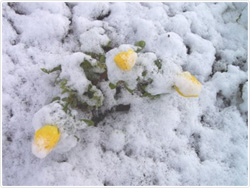WINTER ACONITE

Eranthis hyemalis, or Winter Aconite, is the first flower you will see showing it’s face in late winter sprouting up right through the early March dustings of snow. The bright yellow buttercup bloom is actually a tuber that is native to Europe and Siberia. The name Eranthis is derived from the Greek word er, meaning spring, and the word anthos, meaning flower. This translates to “spring flower”, very appropriate for not only the Winter Aconites’ season of bloom but for how unlikely it is to see such color spring up through the snow in 30 degree weather.
Winter Aconite is a great flower for naturalizing areas, for rock gardens, under trees and border plantings. They prefer moist but well drained soils that are neutral to alkaline. Plant tubers 3” deep and about 2” to 4” apart in late summer to early fall. They grow low to the ground at 3” to 6” tall so make sure you plant them where they will be seen and where there is foot traffic in early March. The flowers open when the sun is shining but close up tight on overcast days. They will bloom for up to a month, often over-lapping with the blooms of Snowdrops (Galanthus spp.). Make sure you allow for them to go to seed so that they will spread naturally for they look best in mass plantings. It will take two to three years for the new seedlings to bloom though. The best display of Winter Aconite I’ve seen in Rochester is in front of the George Eastman house. They spread out in every direction right under a massive Beech tree located in the left of the front yard by the drive into the parking lot.
Winter Aconite is a great flower for naturalizing areas, for rock gardens, under trees and border plantings. They prefer moist but well drained soils that are neutral to alkaline. Plant tubers 3” deep and about 2” to 4” apart in late summer to early fall. They grow low to the ground at 3” to 6” tall so make sure you plant them where they will be seen and where there is foot traffic in early March. The flowers open when the sun is shining but close up tight on overcast days. They will bloom for up to a month, often over-lapping with the blooms of Snowdrops (Galanthus spp.). Make sure you allow for them to go to seed so that they will spread naturally for they look best in mass plantings. It will take two to three years for the new seedlings to bloom though. The best display of Winter Aconite I’ve seen in Rochester is in front of the George Eastman house. They spread out in every direction right under a massive Beech tree located in the left of the front yard by the drive into the parking lot.
February 28, 2010
|
View: 1929







